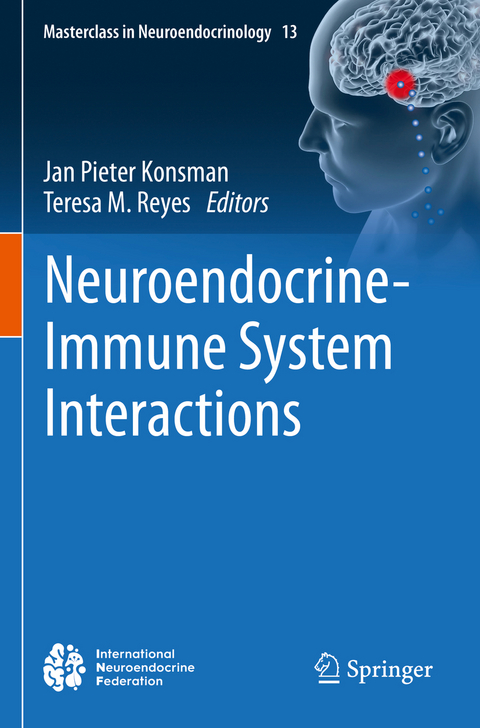
Neuroendocrine-Immune System Interactions
Springer International Publishing (Verlag)
978-3-031-21360-1 (ISBN)
The concepts of the neuroendocrine system and the immune system emerged more or less simultaneously in the second half of the 20th century. Although these systems have a high degree of autonomy, it has also become clear that they interact in many ways and at different levels. This book focuses on the neuroendocrine and immune interactions that are fundamental to normal development and maintenance of health.
The first introductory chapters are devoted to the historical and philosophical concepts within the field, as well as evolutionary considerations, offering critical interdisciplinary perspectives on the development of this field of research. Without attempting an exhaustive overview, the book then introduces some of the regulatory pathways that mediate interactions between the neuroendocrine and immune systems and examines modulating factors such as age and sex. In addition, several chapters address the importance of neuroendocrine-immune interactions in some disease states.
Readers can expect to gain a broad perspective of neuroendocrine-immune interactions in development, health, and disease, along with a critical evaluation of current methods used in the field. Given its scope, the book is essential reading for undergraduate and graduate students with an interest in neuroendocrinology, neuroimmunology, and neuroscience, as well as postdoctoral fellows and established researchers seeking a comprehensive overview and historical perspective of the field of neuroendocrine-immune interactions.
Jan Pieter Konsman, received a Master's Degree in Neurobiology from the University of Groningen, the Netherlands. He obtained his PhD from the Bordeaux University in France for his work on immune-to-brain communication. He then did his post-doctoral training at the University of Linköping in Sweden working on the distribution of the interleukin-1 receptor in the rodent brain. Dr. Konsman next took up a permanent position at the Centre National de Recherche Scientifique in France working on neuroimmune substrates of disease-associated anorexia and encephalopathy. He also holds a Master degree in History and Philosophy of Science and is interested in interdisciplinary approaches of the mind-body problem.
Teresa M. Reyes received her PhD in Psychology from the University of Wisconsin-Madison in which she examined how circulating cytokines affect memory and behavior in a non-human primate model. For her postdoctoral training, she joined the Laboratory of Neuronal Structure and Function, at the Salk Institute for Biological Studies in La Jolla, CA. Here she extended her training to neuroanatomical studies of neuroimmune interactions using rodent models. Dr. Reyes is currently on the faculty of the University of Cincinnati, College of Medicine within the Department of Pharmacology and Systems Physiology. Dr. Reyes's research program is focused on identifying the mechanisms that underlie the effect of adversity in early life on brain development, with a specific interest in neuroimmune interactions and cognition.
Part I. Concepts.- Chapter 1. A History of Immune and Neuroendocrine System Interactions.- Chapter 2. Philosophical Perspectives on Neuroendocrine-Immune Interactions: The Building Block Model and Complementary Neuro-Endocrine-Immune-Microbiota Systems Approaches.- Chapter 3. The Behavioural Immune System of Lower Vertebrates.- Part II. Regulatory Pathways.- Chapter 4. Cytokines and Hypothalamo-Pituitary-Adrenal Axis Activation: Now a Classic of Immune-Neuroendocrine System Interactions.- Chapter 5. Catecholamines and Immunomodulation.- Chapter 6. Neuroendocrine-immune Interactions in Major Depressive Disorder: Glucocorticoids and Glucocorticoid Receptors.- Chapter 7. Brain Fluids, Blood-Brain Interfaces, and Their Involvement in Neuroimmune Regulation During Development and in Adulthood.- Chapter 8. Neuropeptide Binding Autoantibodies Regulating Neuroendocrine Communications.- Part III. Modulation.- Chapter 9. Postnatal Development of Neuroimmune Responses.- Chapter 10. Sex Differences in Neuroendocrine-Immune Interactions.- Chapter 11. Biological Clocks and Immune Function.- Chapter 12. Influence of the Gut Microbiota on Neuroendocrine-Immune Interactions.- Part IV. Disease.- Chapter 13. Energy Balance and Neuroendocrine-Immune Regulation in Chronic Inflammatory and Neoplastic Diseases: An Evolutionary Perspective.- Chapter 14. Autonomic, Immune, Metabolic and Neuroendocrine Dimensions of Anorexia Nervosa: An Integrative View.
| Erscheinungsdatum | 06.03.2024 |
|---|---|
| Reihe/Serie | Masterclass in Neuroendocrinology |
| Zusatzinfo | XIII, 386 p. 29 illus., 26 illus. in color. |
| Verlagsort | Cham |
| Sprache | englisch |
| Maße | 155 x 235 mm |
| Themenwelt | Studium ► 1. Studienabschnitt (Vorklinik) ► Anatomie / Neuroanatomie |
| Studium ► Querschnittsbereiche ► Infektiologie / Immunologie | |
| Naturwissenschaften ► Biologie ► Humanbiologie | |
| Schlagworte | cytokines • Development • dopamine • Evolution • hormones • Immune-to-Brain Signaling • Immunomodulation • Inflammatory Disease • microbiota • Neuroendocrine Diseases • Neuroendocrine-Immune Interactions • Neuroimmune Differences • Regulatory Pathways • Sepsis • Sex Differences |
| ISBN-10 | 3-031-21360-2 / 3031213602 |
| ISBN-13 | 978-3-031-21360-1 / 9783031213601 |
| Zustand | Neuware |
| Informationen gemäß Produktsicherheitsverordnung (GPSR) | |
| Haben Sie eine Frage zum Produkt? |
aus dem Bereich


